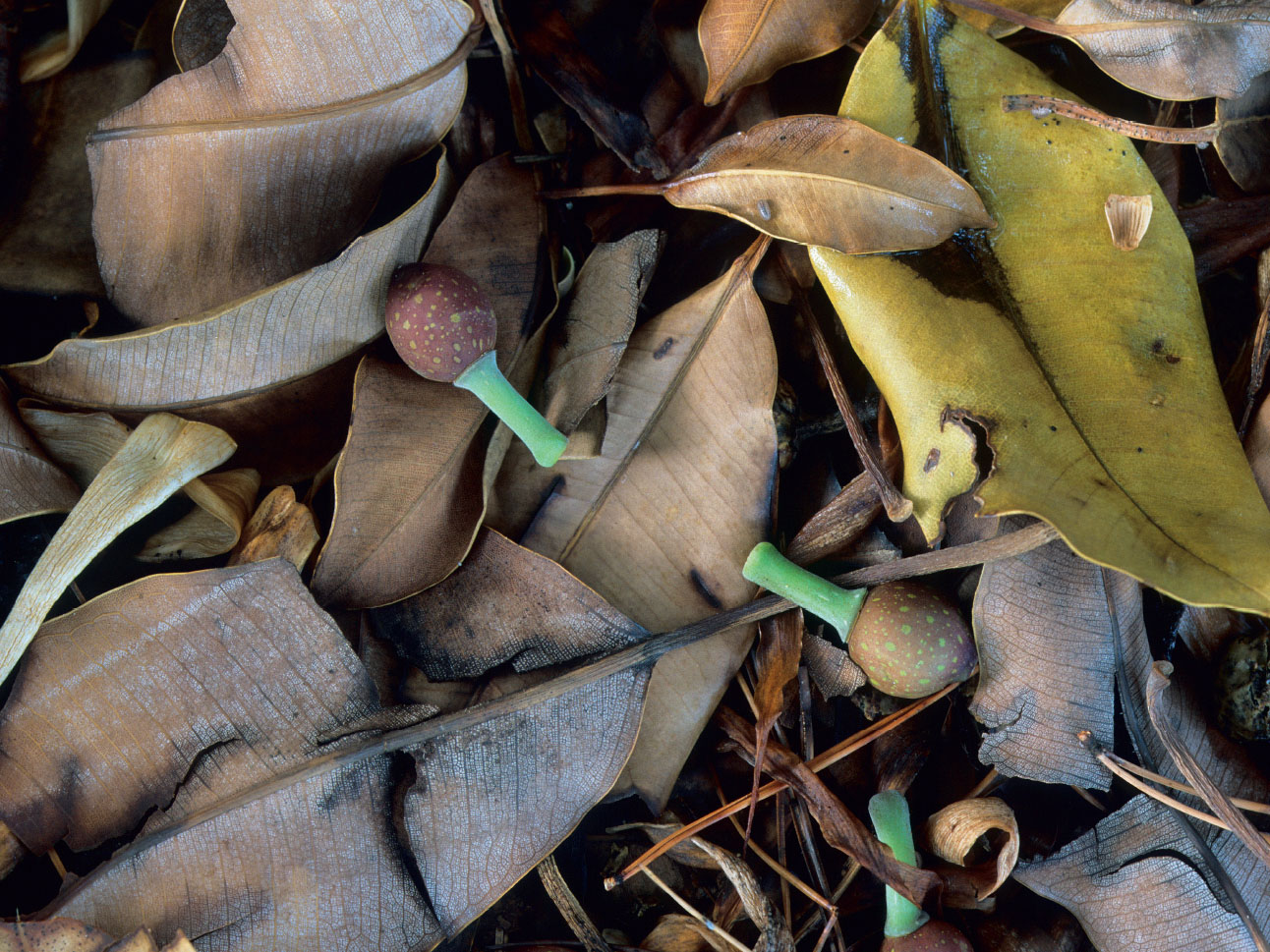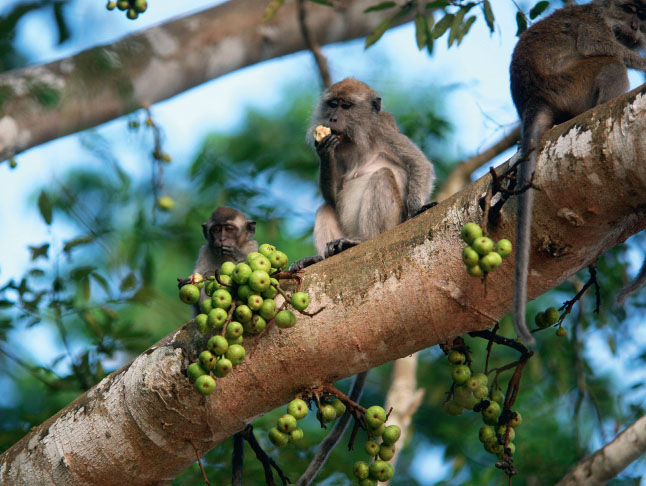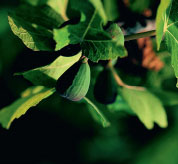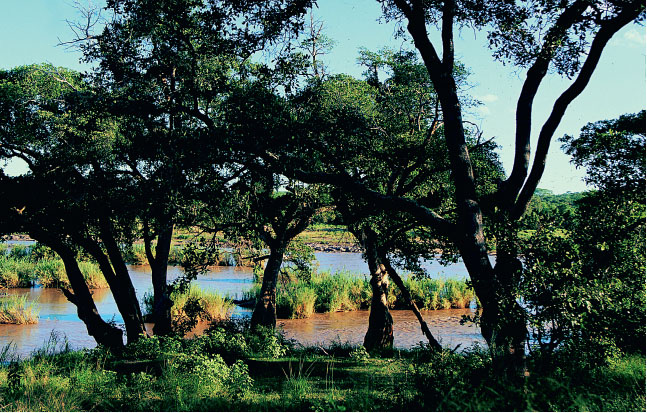
BOTANICAL NAME
Ficus benghalensis (banyan tree) Ficus carica (common fig) Ficus religiosa (bo or bodhi tree) Ficus sycomorus (sycamore fig)
DISTRIBUTION
Ficus species are found in all tropical and some temperate regions.
OLDEST KNOWN LIVING SPECIMEN
The bodhi tree at Anuradhapura, Sri Lanka is 2,300 years old.
RELIGIOUS SIGNIFICANCE
Banyan is sacred to many peoples in India, China and South East Asia; sycamore fig was sacred to the Ancient Egyptians; the bodhi tree is revered by Buddhists and Hindus.
MYTHICAL ASSOCIATIONS
Common fig venerated by the Romans for its associations with Romulus and Remus; banyan believed in both China and India to be the home of demons and tree spirits.
CONSERVATION STATUS
Not classified on the IUCN Red List of Threatened Species.

The fruit of a Moreton bay fig (Ficus macrophylla) lying on the forest floor.
Few groups of trees have the religious significance of figs, and few have played such an important part in human history. Truly remarkable fig trees occur, mostly in tropical regions, all around the world: some are vast, with canopies measured in hectares; some are tropical rainforest giants that strangle their hosts; others are sacred to millions of people; and one individual said to have been planted in 288 BC is still thriving today.
There are some 750 species of fig in the world belonging to the Moraceae family. They are found in all tropical and some temperate regions, in countries as diverse as Mexico, China, New Zealand and Namibia. Fig trees vary enormously in size: while some are only a few metres tall when mature, others can reach heights of more than 45m (147ft) in tropical rainforests. They tend to be evergreen in tropical regions and deciduous in more temperate climates. One of the most famous kinds of fig is the strangler fig. It starts life as a tiny seedling in the crook of a branch high in the forest canopy, from where it extends roots downwards to reach nutrients in the soil of the forest floor. Gradually the roots wrap and widen around the trunk, until the host is eventually killed.

Long-tailed macaque monkeys feasting on the fruits of a rainforest fig in Sabah, Borneo.
The fig tree features strongly in religious history and mythology in various parts of the world. The Romans venerated fig trees because, in the story of Romulus and Remus, their cradle became caught on the branches of a fig in a place that was to become Rome. In China, spirits were believed to live in large fig trees, while on the Indian subcontinent sizeable trees were thought to house demons. The sycamore fig (Ficus sycomorus) was, in the Bible lands, ‘intimately connected with the rites and mysteries of ancient Nature-worship’, as Plants of the Bible (Harold N. and Alma L. Moldenke, 1952) states. The common fig (Ficus carica) was the first plant to be mentioned by name in the Bible, as the source of the ‘aprons’ of leaves made by Adam and Eve to cover their nakedness. The common fig is referred to no fewer than 57 times in the Bible and is generally synonymous with self-sufficiency.

The aerial roots of a large Moreton bay fig (Ficus macrophylla) support the spreading branches above. This feature is common to many other figs.
Pollination
Recent research into fig fossils by Dr Steve Compton of the University of Leeds in the UK has shown that the way in which wasps pollinate fig flowers has remained unchanged for at least 34 million years. Fossils found on the Isle of Wight in the UK show that prehistoric fig wasps used exactly the same parts of their bodies to carry pollen and to get inside figs as those living today. There are about 750 species of fig tree and each needs a specific miniature wasp (just 1.5mm long) to pollinate it.

The banyan tree (Ficus benghalensis) is sacred to many peoples across the Indian subcontinent, the Himalayas, China and many parts of South East Asia. Individuals can grow to an extraordinary size, producing some of the world’s most spectacular trees. The spreading canopy of the banyan can become so huge, that according to legend, Alexander the Great (356–323 BC) and his entire army were able to shelter under a single tree.
The most famous banyan in terms of size, known as the Great Banyan, is located in the Chandra Bose Botanic Garden near Kolkata, India. It started life in the canopy of a date palm growing in the botanic garden only some 200 years ago. From these humble beginnings, it has grown into what is generally regarded as the widest tree in the world. After a lightning strike in 1925, the middle of the tree was removed and, now looking more like a forest than a single tree, it has since formed a colony – composed of over 3,000 aerial roots. Occupying an enormous area of some 14,500 sq. m (156,077 sq. ft), the present crown has a circumference of about 1km (⅝ mile).
There are a number of banyan trees that are considerably older, and other examples of greater size. Perhaps the most remarkable of these is the one growing on the banks of the River Nebudda, east of Bombay. This tree has a truly colossal canopy, measuring an astounding 194m (637ft) in diameter, which is supported by 320 main stems and more than 3,000 smaller ones. It is virtually a one-tree forest.
There is a long history of belief in Asia that demons and spirits inhabit large trees, and banyan trees feature in many traditional stories. One Indian legend refers to a large banyan tree that was the home of a number of tree spirits, who were said to wring the neck of anyone who approached at night. In China, tree spirits were believed to manifest themselves as bulls, serpents and a number of other creatures. One of the most revered trees in China is the great Green Banyan of Ching.
Banyan figs – as well as the sycamore and common fig – were also known to Middle Eastern peoples in biblical times. Some scholars have proposed that the Tree of Life growing in the centre of the Garden of Eden was in fact a banyan.
Ficus religiosa is known by a variety of names, most commonly ‘bo’ or ‘bodhi’. It is a large, fast-growing deciduous tree, with a fluted trunk covered in a smooth grey bark. Unlike many other fig species, it does not have aerial roots and is not a strangler, but splits its host tree as it grows. It has large, heart-shaped leaves that taper to a point and these are set on long, slender stalks, causing the foliage to move in the lightest of breezes.
The bo is one of the most sacred trees in India, Sri Lanka and Nepal, where it is venerated by both Hindus and Buddhists. The individual known as ‘the Bodhi Tree’, which now grows at the Mahabodhi temple in Bodh Gaya in north-east India, is said to be a direct descendant of the tree under which Siddhartha Gautama, the founder of Buddhism, found enlightenment over 2,600 years ago. Images often depict this event, showing Buddha under a large, spreading bo tree, with demons attacking him on one side and vanquished demons escaping on the other. According to ancient tradition, the original bodhi tree at Bodh Gaya was nurtured by the earth goddess and, at the very moment of Buddha’s enlightenment, all the flowering trees in the world burst into flower and became heavy with fruit. Buddhists regard the bodhi as the personification of Buddha.
The bo tree is also revered by Hindus, who have a strong religious objection to cutting it down. In the Hindu religion, Vishnu (the second member of the Hindu trinity) is said to have been born under a bo tree and is often depicted sitting on its heart-shaped leaves. The bo tree is often planted in the grounds of temples and, of all the sacred trees of India, it is the most widely worshipped.

The sacred Bo tree in Anuradhapura, Sri Lanka, is the oldest verifiable tree that is not a conifer.

The fig tree, not that for fruit renowned, But such as at this day to Indians known In Malabar or Deccan spreads her arms, Branching so broad and long, that in the ground The bended twigs take root, and daughters grow About the mother tree …
JOHN MILTON, PARADISE LOST, IX, 1101–1106 (1667)

The most famous sacred bo tree in Sri Lanka is located in Anuradhapura and is said to be the oldest tree in the world with a known planting date. This fig is said to have grown from a branch taken from the original bodhi tree in India under which Buddha received enlightenment; the branch was sent to King Devanampiyatissa by India’s King Asoka in 288 BC. The king planted it and prophesied that it would thrive forever. Other bo trees found in temple gardens across Sri Lanka are all thought to be cuttings from the famous tree at Anuradhapura.

Sycamore figs were believed by the Ancient Egyptians to line the route to the afterlife.
The sycamore fig (Ficus sycomorus) is a robust, wide-spreading, semi-evergreen tree found in an area stretching from the Middle East, North and central Africa as far south as KwaZulu-Natal in southern Africa. Unlike the banyan, the sycamore fig does not spread out laterally with the aid of aerial roots. Instead, its main trunk, clad in pale brown papery bark, divides into numerous spreading branches close to the ground. It is not a tall tree, however, typically growing to just 9–12m (30–40ft), and large specimens have a spreading canopy of only about 36m (120ft) in diameter. The largest sycamore fig (and probably the oldest) stands in the Kruger National Park in South Africa. In comparison with other trees of known age, this fig must be well over 1,000 years old.
The sycamore fig was particularly important to the Ancient Egyptians, who revered impressive trees. It grew abundantly and was considered to be one of the two most sacred trees of Ancient Egypt. As such, it often featured in Egyptian sculptures and was occasionally represented as the ‘tree of life’. A mythical sycamore fig even stood on the path to the afterlife, supplying food and drink to the souls of the dead on their journey to the Otherworld.
Domesticated edible figs, such as this one near Rimini, Italy, will not produce fruit without the aid of minute flightless wasps.